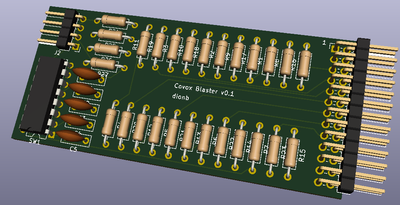First post, by dionb
- Rank
- l33t++
After a year or so of building other peoples' replica sound cards, the inevitable has happened - I've started one (or actually two) myself.
Given it's my first (and second) PCB project, I wanted to keep it simple. My inspiration came when it turned out my beloved Aztech NXPro wasn't as 100% Sound Blaster compatible as I thought and I needed to replace it with my Snark Barker SB1.0 clone. Works fine, but I lost Covox support. And Covox is arguably the simplest sound device out there. The easy solution would be to go for one of the many external dongles out there, but I hate dongles. And this machine has an internal parallel header. So an idea started to form...
The first iteration of the idea was simple: mount a small PCB with 3.5mm jack and the resistor ladder on an external bracket and connect that with a flatcable to the parallel header. Thus the design I'll call Internal Covox was born. I was inspired by Serdaco's CVX4, both in the use of identical resistors to minimize variation and in the addition of a dipswitch to enable different filter/volume options. Note that I didn't copy any of his schematics, I just went to the Speech Thing patent with its very convenient detail and used that. Any errors are entirely my own, and errors there certainly are. I quickly cobbled together a design for this and shot of a PCB order and then started to be confronted by my many mistakes. First up I should have used KiCad right away, instead I used EasyEDA. It seems very user-friendly, but not having as much focus on footprints leads to mistakes (at least in an absolute beginner). It should - hopefully - still work, but even buying the smallest resistors I can find they won't fit properly and the size means I have to use 1% instead of 0.1% resistors. Not good - but in a week or so we'll find out how not good.
Other things aren't mistakes as such, but realizations after the fact. The PCB is cheap as dirt, but two parts are pricey: the Keystone 9202 ISA bracket and the (connectors for the) flatcable. Also, having *yet another* flatcable draping through the system is very '90s style, but not my preferred situation. So how could I avoid cables and the need to buy a bracket... enter the Covox Blaster!
(note: male header and IC at SW1 are incorrect, but holes are)
What is it?
A Covox resistor ladder DAC on a daughterboard that can be plugged straight into an internal parallel header. The other end has a standard MPC-2 'CD Audio' connector that can be fed into a sound card, or easily connected to something else, like a 3.5mm jack socket at a convenient location. By using either a straight or right-angle female 2x13 connector it can interface with a header on a card or on a motherboard respectively. The dipswitches let you mess around with the filter, with capacitor values from 0.1nf to 10nf. The resistor in the patent is supposedly 15k but it has been measured at 25k, so I let you select both (and a few higher values too, using 220k base and resp 57k, 57k and 37k on the dipswitch - all together in parallel they add up to 15k)
Everything uses THT, mainly because I don't want my soldering skills (and equipment) to be the weakest link. Because it's still electrically connected to a parallel port, compatibility should be identical to the original. I realize I/O cards with internal parallel headers are uncommon, but they certainly exist - and there are LOT of motherboards out there with the headers. Still, the image I have in my mind is a big I/O card with parallel header with daughterboard, connected to a sound card with daughterboard too. Practically useful? Nope. But why not? 😜
So, what do people think?
